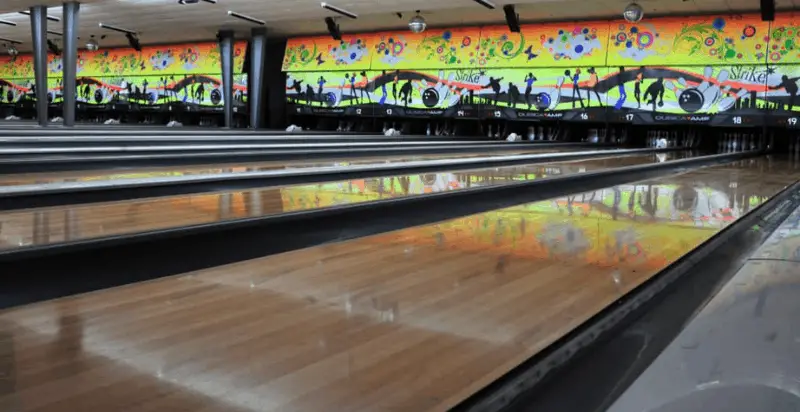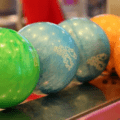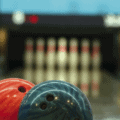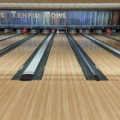The game of bowling seems quite simple, doesn’t it? You just deal with a heavy ball, adjust your position, and hit straight at the pins. If you miss the pins then something is probably wrong with your aiming or throw so you try to fix it.
However, it is not just your style or the ball condition that can meddle with your results. Apparently, the lane itself is a factor that will either help you achieve your target or make the process more difficult for you. Now, the question is how does a simple, straight wooden or synthetic bowling lane change your game?
Well, the same way it deals with those heavy balls and does not crack- with oil. When we go bowling we mostly focus on the length of the lane, the weight of the balls and other players. However, one thing that deserves our attention more is the lane itself.
Have you noticed how it glows under the lights? Is wood or synthetic materials supposed to glow like that alone? Haven’t you ever wondered how the heavy bowling balls roll on a wooden lane that is supposed to offer a lot of friction?
If there was no oil on the lane then your bowling ball would not have reached even half way. Bowling lanes have oil on them and you have to know how to deal with them in the best possible way to improve. So, here is everything about oil on bowling lanes: Understanding oil patterns & why they are so important.
Oil On Bowling Lanes: Why?
Protecting The Lane
A wooden or synthetic lane is not strong enough to handle the heavy impact that heavy bowling balls have on them. Moreover, bowlers often mess up and make the impact even more damaging. If the lanes were not covered in oil, there would be dents, burn spots and more on the lane due to the impacts.
To Enable The Game
Often when you are trying to wear a bracelet or bangle or trying to make your rusty machine work again, you use oil to lubricate it and make it slippery enough to move. The same technique applies in the case of bowling. You cannot expect a porous lane to easily transfer a rolling ball. The oil on the lane makes it possible for the ball to reach the end.
Changing Difficulty Level
Any game would be boring if the players only had one easy level to deal with. The oil patterns on the bowling lane are of various types offering grip on the lane at places and not on others. This requires the players to not only correct their movements but also study the lane to understand the pattern and hit a target spot so that they can knock all the pins.
[su_highlight background=”#1c79c0″]Additional Read: Best Bowling Balls For Hook[/su_highlight]
Oil on Bowling Lanes: The Patterns
 When you play on a Carrom board, you use powder to help the movement of the pieces. Similarly, oil on the bowling lanes provides the minimum hook to the bowling balls. So, some parts of the bowling lane have more oil (also called saturated or wet parts) and some other parts have less or no oil (dry areas).
When you play on a Carrom board, you use powder to help the movement of the pieces. Similarly, oil on the bowling lanes provides the minimum hook to the bowling balls. So, some parts of the bowling lane have more oil (also called saturated or wet parts) and some other parts have less or no oil (dry areas).
In fact, the parts with the most oil will offer almost no hook to the ball and the parts with less oil will increase the friction and offer more hook to the ball, limiting its movements. So, how much of each part exists for how long and where is called the oil pattern of bowling lanes.
Apparently, this pattern varies and with it, the difficulty level also varies. However, there are mainly two kinds of patterns based on your bowler’s skill level.
House Patterns
If you are just a beginner and have tried out bowling, it is possible that you have played on a lane with house patterns. Apparently, this pattern is quite forgiving as it lets some errors pass by. In fact, it has more oil towards the center of the lane and less on the outside.
So, if you accidentally throw a ball too right or left, the grip from both sides due to lack of oil will bring your ball towards the center. Again, if you manage to throw straight, the ball will go straight easily because of the minimum friction provided by the well-saturated center.
Sport Patterns
This is actually the pattern that professionals face in tournaments. These patterns give room to fewer errors. The bowlers need to be very precise in their throws and aims as otherwise, the ball will just go where the bowler actually threw it.
Apparently, sports patterns have wet spots both on the center and also outer sides. This makes the understanding process more difficult and the bowler has to be very strategic in where he throws.
The Professional Bowling Association (PBA)
This is the association that usually sets the patterns for professional tournaments. In fact, they use 16 different patterns along with various variations among them.
Kegel
Kegel is a bowling brand and it also has its set of patterns that many of their own tournaments and associations use. Apparently, it offers two main types of patterns that are again divided into three types based on the difficulty level.
Oil On Bowling Lanes: What You Can Do About It
Apparently, lanes have oil patterns based on what pattern is pre-programmed in their lane machines. So, what you can do to have a better chance at succeeding is:
1. Know The Pattern You Are Playing On
Unlike many other things, patterns are not some secret that the club has to keep. You can ask them about the name of the pattern the lane uses or ask for a map to see it.
2. Use The Rule Of 31
The oil pattern will definitely have a length it extends up to. You have to find out what this length is and subtract 31 from it. Apparently, the answer will be the length at which the bowling ball will break towards the pocket.
3. Adjust Your Stance
Based on the wet and dry spots, you can adjust your stance when you see that you cannot hit your target.
4. Or, Adjust Your Style
This is something not many will be willing to do. However, this is another way you can deal with the oil patterns to succeed.
Much like your height, weight, strength, skills, etc, oil patterns of a bowling lane affect how you play. This is why you cannot ever ignore it.
Furthermore, it is not enough to just know about the patterns. You have to know it and learn to practice your way around it.
You may find the below articles interesting –
- Best Bowling Balls: Reviews & Buyer’s Guide
- Best Bowling Balls for Beginners
- Best Bowling Balls for Straight Bowlers
- How to Build An Effective Bowling Ball Arsenal

I’m Lia and I love playing games. I started this site to share things with friends and they encouraged me to post more and now I’m trying to share things with the world – indoor and outdoor sports, and board and bar games. I write about things like Bocce, Croquet, Billiards, Darts and other fun ways to enjoy time with your friends and family!







